When the NFL decided to revamp its kickoff structure last year, it didn't start from scratch. The league instead leaned into a model from the now-defunct XFL, one that had been developed and tested during a five-year period from 2018 to '23. NFL rule-makers imposed a few tweaks and managed to raise the return rate while lowering the injury rates in 2024, and owners are soon expected to renew those plans for another season.
The kickoff story is one of many reasons to monitor spring football, where pro-level level innovation continues to percolate. The United Football League, the product of a merger between the XFL and USFL, will open its second season this weekend with a series of on-field and technological advancements that could find their way into NFL discussions in the coming years.
"We have this unique ability to introduce innovation that has the ability to impact the game of football broadly," said Scott Harniman, the UFL's senior vice president of technology and leader of its FAST (Football Advancement through Sports Technology) program. "It's not just for the UFL, not for spring football. We have to introduce these things that can impact and advance the game of football."
Let's take a closer look at eight UFL rules and innovations to monitor for the 2025 season.
Kickoff aligned with likely NFL changes
As part of its merger negotiations last season, the UFL adopted the USFL's traditional kickoff for 2024. But it will return to the XFL version this season, with a few tweaks. Kickers will line up at their own 30-yard line, with touchbacks marked at the 40-yard line. Balls that don't reach the landing zone, from the 20-yard line to the goal line, will also be marked at the 40.
Dean Blandino, the UFL's vice president of rules and officiating, is projecting a return rate of at least 80% for the 2025 season. In 2024, the NFL kicked off from the 35 and marked touchbacks at the 30, leading to a return rate of 32.8%.
"The tweaks were really things that the NFL is considering and may end up doing," Blandino said.
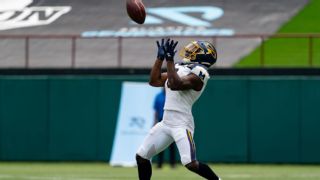
No onside kicks
The difficulty of recovering onside kicks in this alignment prompted the UFL to eliminate them and instead give teams an opportunity to convert what amounts to a fourth-and-12 play from their own 28-yard line to retain possession after a score.
NFL owners have in the past rejected this option because they consider it gimmicky, but last season, the NFL's onside kick recovery rate was .06%. The UFL calibrated this option in hopes of achieving a conversion rate between 13% and 15%, Blandino said.
Coaches could get two 'super challenges'
The UFL was pleased enough with its 2024 introduction of the "super challenge" -- giving a coach the option to challenge one officiating decision of any type, including penalties or no-calls -- that it will give them a second in 2025 if their first is successful.
The UFL ruled in coaches' favor on 13 of 39 such challenges last season. League rules allow Blandino or colleague Mike Pereira to review any calls that relate to health and safety, along with any issues of game administration, without challenges. So the majority of coaches' challenges last season related to pass interference or other downfield calls/non-calls.
The NFL's attempts to review pass interference calls in 2019 failed largely because the league's standard for overturning calls was too high. Blandino said the UFL standard for changing an on-field decision in real-time is "if we would downgrade the official for their decision if we were evaluating the call after the game."
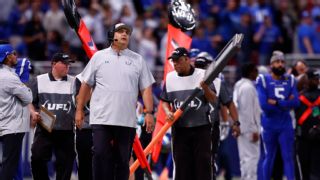
PATs and OT rules remain intact
As in previous years, UFL teams won't kick extra points after touchdowns. Instead, they will get three options for an additional offensive play:
A 1-point conversion from the 2-yard line
A 2-point conversion from the 5-yard line
A 3-point conversion from the 10-yard line
During the 2024 season, coaches elected for the 2-point conversion on 61.8% of opportunities. They went for one point at a rate of 34.7% and for three points at a rate of 3.4%.
The math created by those options lowers the chance for overtime, and the UFL had two such games in 2024. Overtime rules call for the teams to get alternating possessions from their opponents' 5-yard line until one team finishes a round in the lead.
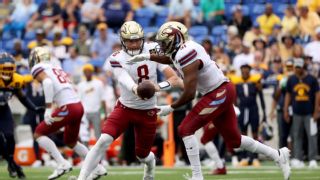
Automated first-down measurements
The UFL will enter its second season using a technology known as "TruLine," rather than chains and down markers, when officials need to measure if the ball has been spotted past the line to gain.
On-field officials are still responsible for spotting the ball itself, which requires them judge its location when the ball carrier is ruled down. But when a measurement is needed -- typically when the ball is within 30 inches of the line to gain -- the UFL will employ a series of cameras to reliably measure within 10 milliseconds of their activation, Harniman said. Animation, enhanced for 2025, will then be displayed on stadium scoreboards and usually on the television broadcast.
The NFL has been experimenting with a similar technology through its Hawk-eye cameras.
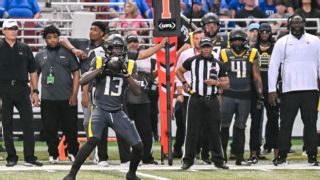
More players with helmet speakers
The UFL will allow up to 10 players to be involved in coach-to-player communication while on the field, an increase from eight last season. The NFL allows two, one for the quarterback and a second to a defensive player signified by a green dot on his helmet.
Two of the players are required to be quarterbacks, but coaches can select the other eight, according to Harniman. The idea is to minimize the chance for confusion on offensive playcalls, as well as to maintain a faster and more efficient pace of play.
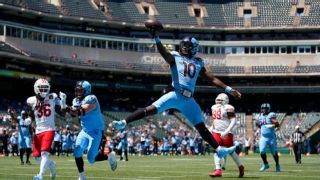
New uses for 'Smart Balls'
The UFL will test the uses for sensor technology it has placed in footballs used in practice and offseason showcase events.
While there might eventually be uses for Smart Balls in officiating, such as to spot where a punt went out of bounds, for now the UFL will be focused on using them as secondary player evaluation tools.
The data, for example, could be used to establish the probability of completion on throws during a practice using models that incorporate inputs such as spin rate, velocity and distance the ball is thrown.
Body camera video
In selected games on a weekly basis, Fox and ESPN will outfit between two and four players with body cameras embedded in a vest below the shoulder pads. They're likely to use players in the defensive backfield to provide the perspective of running toward the ball and both audio and video of the ensuing contact.
The cameras are AI-stabilized, Harniman said, to minimize the shaky nature of previous iterations of cameras attached to both players and officials.
"I don't think you can experience the physicality of the game and the speed of the game in a way that this shows," Harniman said. "It has never before been able to be seen like this."

